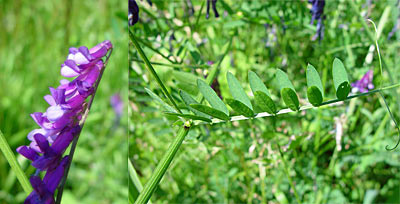Relatives
Vicia varia Host - Vetch changeable or variabile.
Taxonomic position.
Family Fabaceae Lindl. Genus Vicia L.The basic synonyms:
Vicia villosa Roth subsp. varia (Host) Corb.; V.dazycarpa auct.Morphology and biology.
An annual plant 50-130 sm in height. All plant is pubescent. A stem is thin, ridge, rigid. The axis of a leave comes to an end as a branchy cirrus. Stipules are 7-10 mm in length, lanceolate or linear - lanceolate, at the bottom leaves - semi-hastate. Leaflets 8-12-paired, oblong-linear or lanceolate, with an edge. Peduncles together with a brush are equal to leaves on length or some longer them. Brushes are multifloral, not dense. Flowers are not large, narrow, 12-15 mm in length. A cup is campanulate, its bottom teeth are longer, than top's ones. Petals are blue-violet, rare - white. Turned back part of a flag is narrow, in 2 times shorter than unguis or has the same length with it. Keel on its top has a dark-violet stain. Beans are wide, up to 7 mm in width, oblong, 23-25 mm in length, naked. There are 2-6 rather large, compressed - spherical, purple-brown seeds in the pod. Blossoms in June - July, fructifies in August - September. Insect-pollinated.Distribution.
The south of Sweden, Middle Europe, the Mediterranean, the Balkans - Asia Minor. In territory of the former USSR: Caucasus - Ciscaucasia, Dagestan, the Western and Eastern Transcaucasia.Ecology.
On fields, in crops, on edges of roads, on bushes.Use and economic value.
A good fodder plant, the species is known as a cultivated plant in some European countries and in the USA.References:
Cherepanov, S.K. 1995. Plantae Vasculares Rossicae et Civitatum Collimitanearum (in limicis USSR olim). St-Petersburg, "Mir I Semia", 990 p. (in Russian).Flora USSR, 1948. Vol. XIII. Shishkin B.K., Bobrov E.V. (ed.) M.-L.: Publishing House of Acad. Science, p. 451. (in Russian).
Grossheim, A.A. 1945. Flora of Caucasia. Baku, Publishing House of Azerbaijan Acad. Science, Vol. III, 311 p., appendix. (in Russian).


